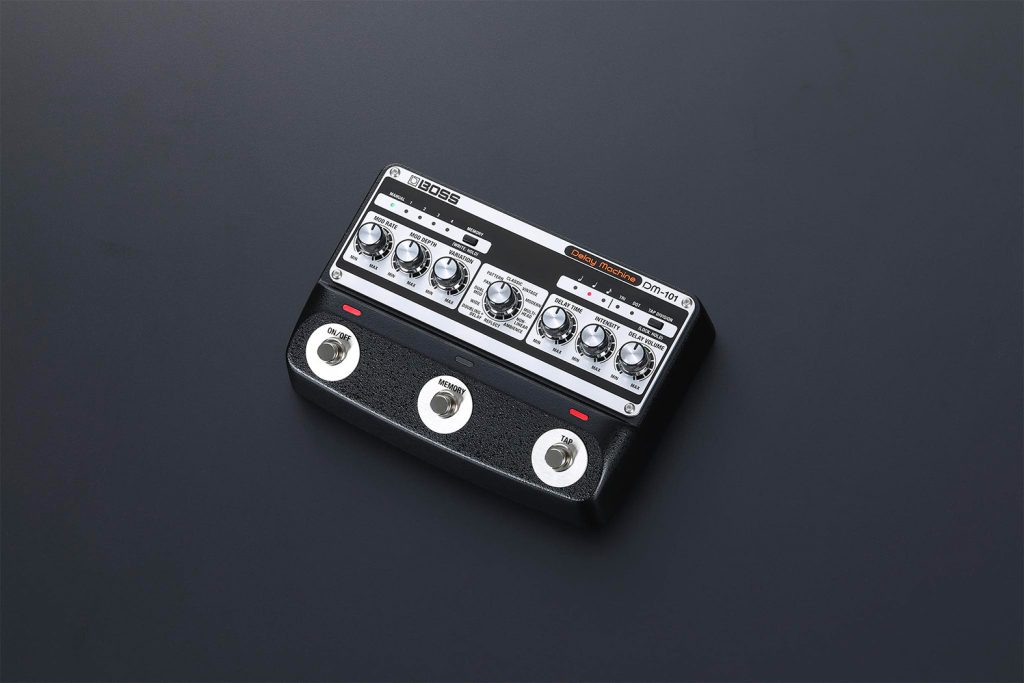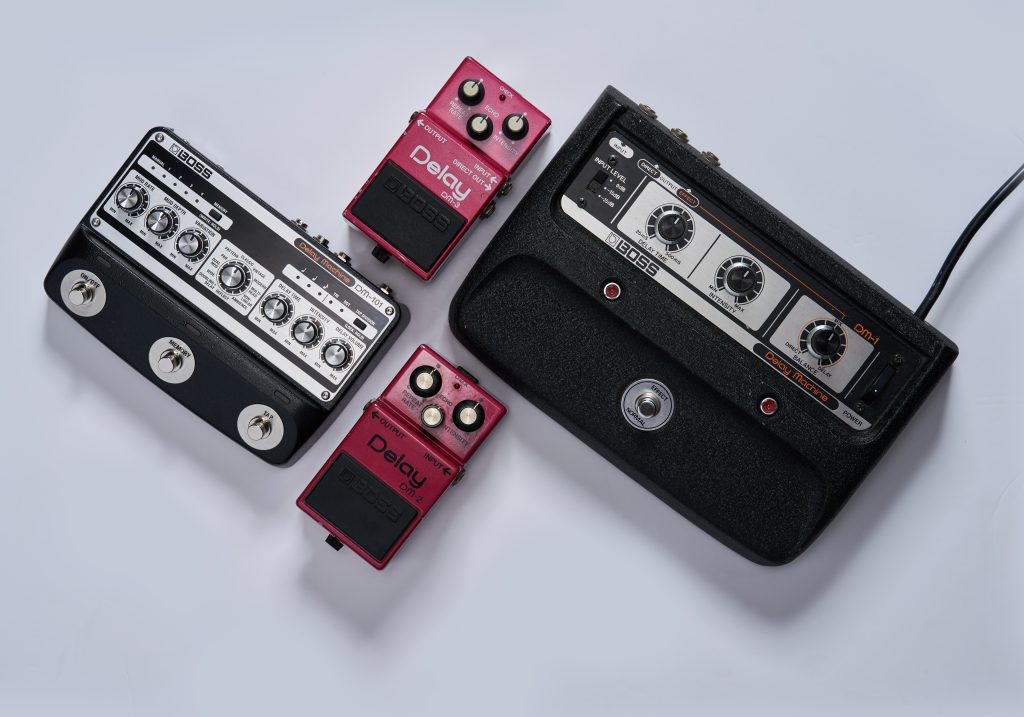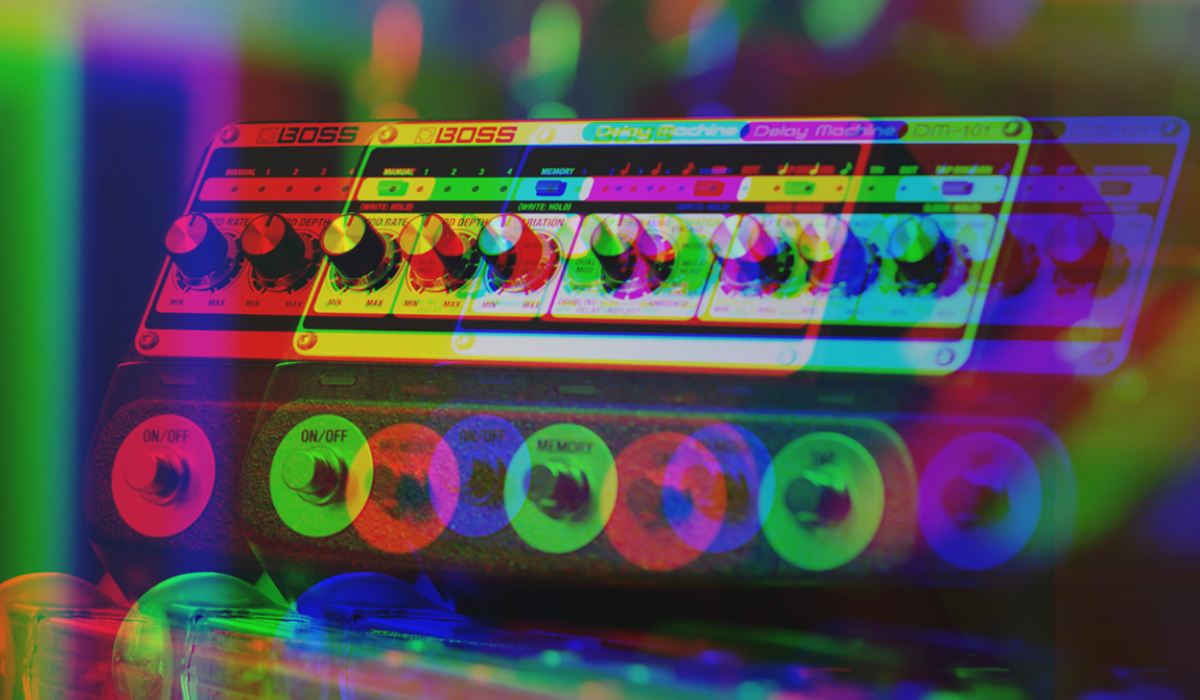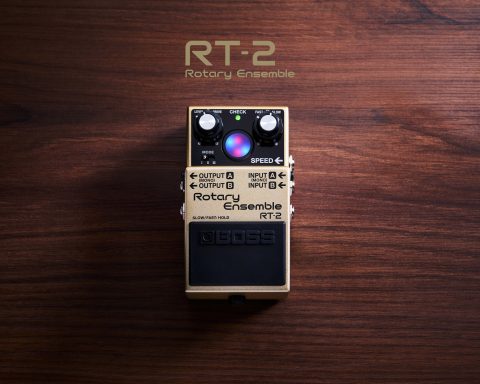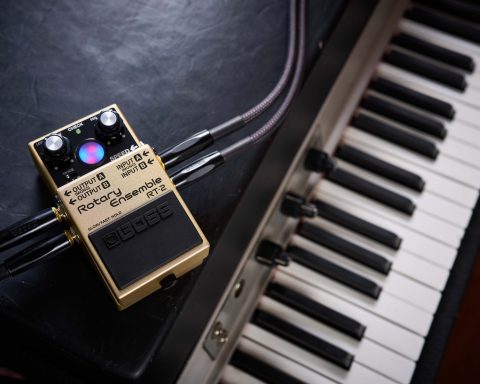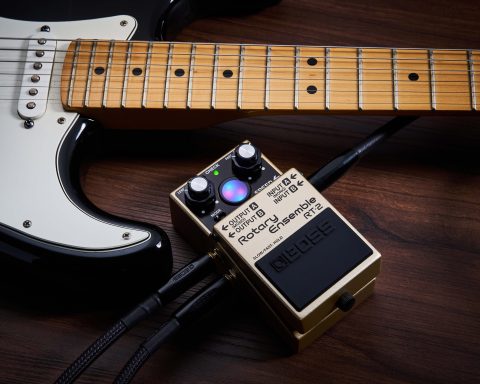過去50年以上にわたり、BOSSは125種類以上のユニークなエフェクト・ペダルを開発し、鮮やかな音色とビジュアルのバリエーションが豊かに存在しています。その中には、オーバードライブやディストーション、リバーブといったギターの定番エフェクトや、スローギアやスライサーといった特殊エフェクトも含まれています。業界初のエフェクトを多く輩出する中で、1976年にはBOSSはコーラス・エフェクトのパイオニアとなり、今や世界中のミュージシャン、オーディオ・エンジニア、プロデューサーの標準となっています。
BOSSのペダルの多くは、ギタリストやその他のミュージシャンにとって欠かせないサウンド・ツールであるディレイ・エフェクトに特化しています。これまでに、ディレイやエコーを扱った30種類のモデルが登場しています。ここでは、1978年から現在に至るまでのBOSS ディレイ・ペダルの歴史を振り返ります。
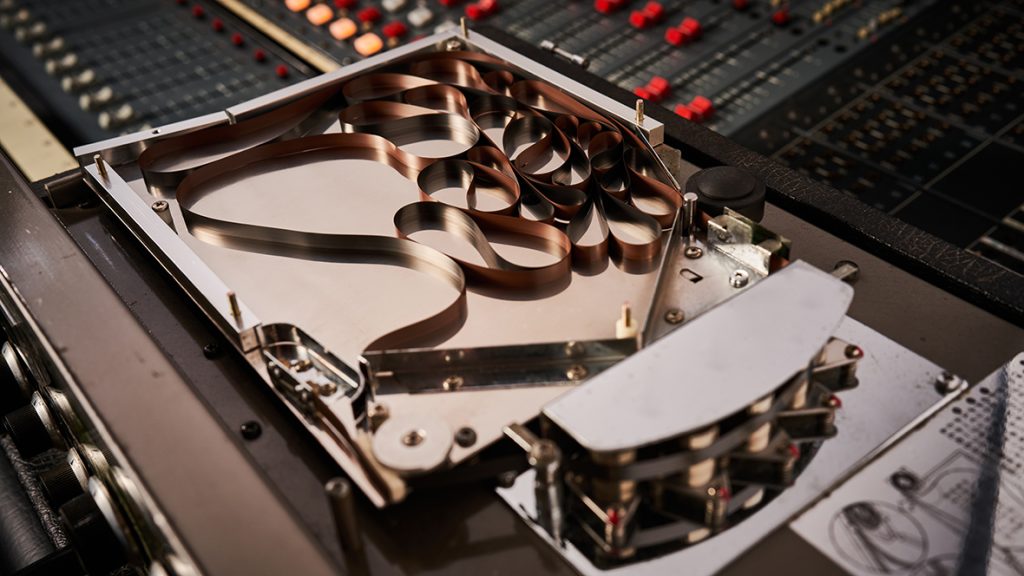
ディレイに捧ぐ
本題に入る前に、ディレイの背景についてお話しします。BOSSとその親会社であるRolandは、創業当初からディレイ・エフェクトにおける革新的なアプローチを続けてきました。Rolandでは1974年に初登場したRE-201スペース・エコーが、テープを基調としたディレイ機器の最高峰として広く知られています。1983年以降、SDE-3000 デジタル・ディレイのようなラック・ユニットが音楽技術の最前線に立ち、有名ミュージシャンのギター・エフェクト・システムに不可欠な存在となりました。
BOSSも長年に渡りラックやテーブル・トップのディレイ・ユニットを製作してきましたが、主な焦点はペダル型エフェクトに置かれています。優れたサウンドと操作性、そして全ての演奏者にとって使いやすい機材を追求してきました。こうした目標を実現するため、BOSSはアナログとデジタル両方の技術で常に限界を押し広げ、業界に影響を与え、リードし続けています。
それでは、前置きはこの辺りにして、本題に入りましょう。
「アナログDM-1は特徴的なサウンドを提供し、最大500msのディレイ・タイムを実現しました」
1978: DM-1 Delay Machine
多くのミュージシャンがエコーのエフェクトを欲していた1970年代、最先端機器であるテープ式のスペース・エコーのような製品は非常に高価で、手が届かないものでした。そんな中、BOSS初のディレイ・ユニットであるDM-1 Delay Machineが、より手頃でコンパクトな選択肢として登場しました。スペース・エコーと比べると周波数帯域や汎用性は限られていましたが、アナログなDM-1は個性的な音色を持ち、最大500msのディレイ・タイムを実現しました。後に登場するDMシリーズのBBD(バケット・ブリゲード・デバイス)方式とは異なり、DM-1の回路はCCD(電荷結合素子)を使用しています。これは後にデジタルカメラでも広く使われる電子部品です。
BOSSの伝説的なBOSS CE-1 Chorus Ensemble(世界初のコーラス・ペダル)に詳しい方なら、DM-1も同じ頑丈な金属製の筐体とAC電源仕様を採用していることに気が付くでしょう。これはどちらも同時期に製造されていたためです。DM-1はわずか2年未満しか製造されていないため、中古市場では希少で、見つけることができたとしても高額で取引されています。

「最大で300msのディレイ・タイムを実現するために、BOSSのエンジニアたちはDM-2に使用されているBBDチップの性能を限界まで引き出す必要がありました」

1981: DM-2 Delay
次に登場したBOSSのディレイ・マシンは、クラシックなツールとして知られるDM-2です。1977年にコンパクト・ペダルのシリーズが登場して以来、音楽シーンでの人気が高まり、DM-1のコンセプトをより小型のフォーマットに収めるのは自然な流れでした。DM-2の回路設計にはDM-1で使用されたCCDの代わりに、バケット・ブリゲード・デバイス(BBD)が採用されています。
DM-2で最大300msのディレイ・タイムを実現するため、BOSSのエンジニアはペダル内のBBDチップの能力を限界まで引き出しました。その一環として、エフェクト音の周波数を制限する方法が取られました。これがDM-2特有の温かみと包み込むようなトーンを生み出し、ギターなどの音と非常に相性の良いサウンドを実現しています。
廃盤から30年以上経った今もなお、DM-2は中古市場で高い人気を誇っています。2014年に登場したWaza CraftのDM-2Wは、DM-2のオリジナル・サウンドを忠実に再現しつつ、さらに幅広いレンジと新機能を追加したモデルです。
「廃盤から30年以上経った今もなお、DM-2は中古市場で高い人気を誇っています」
1983: DD-2 Digital Delay
BOSSとRolandは音楽機材業界における数多くのマイルストーン製品で広く知られていますが、その中でもDD-2は間違いなく重要な存在です。世界で初めてデジタル・ディレイをペダル形式で実現し(BOSS初のデジタル・ペダルでもあります)、スタジオ用ラック・プロセッサーの高音質と広いディレイ範囲を、手軽にミュージシャンが手にできる形にしました。
1980年代初頭、デジタル技術は音楽機材の世界で大きな進化の原動力となりました。当時、Rolandのフラッグシップ・デジタル・ディレイはSDE-3000というラック・ユニットで、録音スタジオでよく使用されていました。その豊かでギターにも相性の良いサウンドにより、プロの演奏者が使用する大規模なラック・システムにも組み込まれていました。しかし、SDE-3000の価格と大きさは、多くの働くミュージシャンやアマチュア・プレイヤーにとって手の届かないものでした。BOSSは2023年にSDE-3000をペダル形式で再発表しましたが、それについては後述します。

「DD-2はスタジオ用ラック・プロセッサーの高音質と広いディレイ範囲を、手軽にミュージシャンが手にできる形にしました」
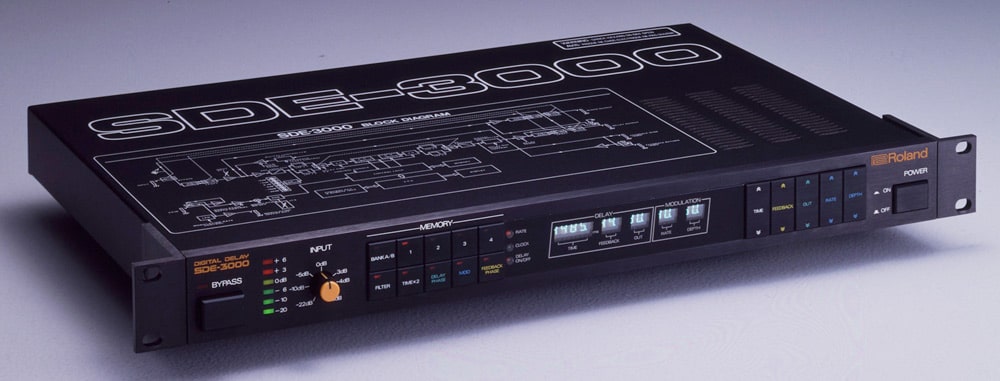
SDE-3000は、この製品のために特別に作られたカスタムICチップを使用していました。DD-2のオリジナル・コンセプトは、BOSSのエンジニアたちが驚いたことに、この強力なチップがコンパクトなペダルの筐体に(ギリギリではあるものの)収まることを発見した際に生まれました。次の課題は、残りの電子回路をすべて収め、さらに9Vの電池で駆動させることでした。
度重なる開発期間を経て、DD-2はついにリリースされます。最大800msのディレイ・タイムとクリアかつ温かみのある音色で、このペダルは瞬く間にヒット商品となり、必須アイテムとなりました。その後、DD-2はBOSSや他のメーカーから続々と登場するデジタル・ディレイ・ペダルの基準を築きました。全てのデジタル・ディレイ・ペダルが、この革新的なペダルにルーツを持つといえるでしょう。
「DD-2はBOSSや他のメーカーから続々と登場するデジタル・ディレイ・ペダルの基準を築きました」
1984: DM-3 Delay
デジタル・ディレイ・ペダルのDD-2が人気を博していた一方で、アナログのDM-2は、手頃な代替品として親しまれるようになりました。その後継として登場した次世代モデルのDM-3は、次世代と言いながらもアナログ仕様でしたが、DM-2の改良版で少し手頃な価格設定でした。DM-2の進化版としてディレイ音をクリアにし、ノイズを抑えるデザインの調整が施されており、アナログBBD回路の性能を最大限に引き出すための技術開発が行われました。DM-3には、ドライ信号とエフェクト信号を別々のアンプに送るためのジャックや、他のBOSSペダルには見られない独自のノブが搭載されています。
エフェクト愛好家の中にはDM-2の方が優れた音色だと評価している方もいますが、DM-3も音の傾向は非常に似ています。繰り返しのディレイ音はよりクリアで洗練されている印象なので、特定の用途にはむしろ適していると言えるでしょう。
1980年代後半には、ディレイの分野でデジタル技術が主流となり、DM-3は1988年半ばに生産終了となりました。これは、2014年にWaza Craft DM-2Wが登場するまで、BOSSのラインナップにおける最後の完全アナログ・ディレイ・ペダルでした。
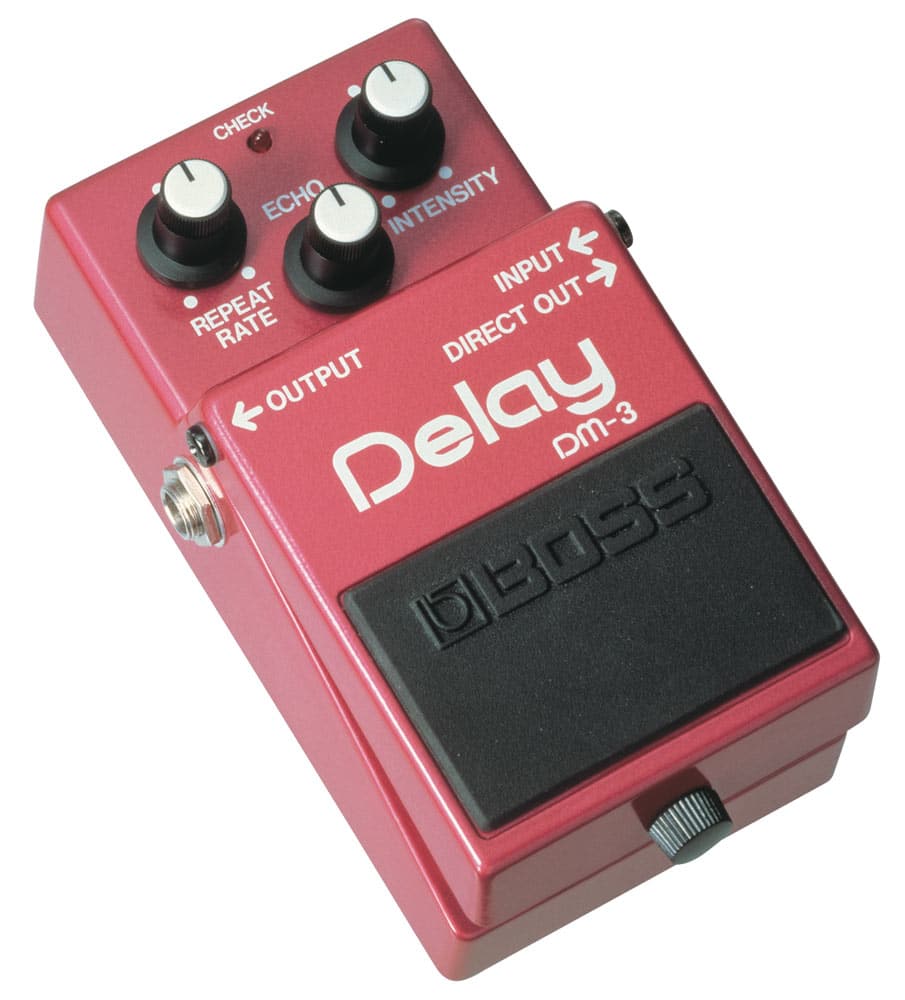
「BOSSのラインナップにおいて、DM-3はWaza Craft DM-2Wが登場するまでの26年間、最後の完全アナログ・ディレイ・ペダルでした」

1985: DSD-2 Digital Sampler/Delay
BOSSはDD-2のディレイ機能に加えて、当時としては斬新なアイデアだったフレーズ・サンプラー機能をDSD-2に取り入れました。サンプラーは登場してからしばらく時間が経っていたものの、当時はまだスタジオで使われる高額な機器として扱われていました。BOSSの哲学に基づき、この進化した技術はDSD-2によって全てのミュージシャンの手の届くものへとなりました。
DSD-2のフレーズ・サンプラーは800msのオーディオを録音(サンプリング)し、ペダル・スイッチを押すことでワンショット再生することが可能です。また、ドラムパッドや他の外部機器からサンプルを再生するためのトリガー入力も備えていました。現在の標準と比較するとサンプリング機能は限られているものの、DSD-2(および後継機DSD-3)は、後に登場する革新的なBOSSループステーションの先駆けと言えます。
「DSD-2は、後に登場する革新的なBOSSループステーションの先駆けと言えます」
1986: DD-3 Digital Delay
デジタル技術が普及するにつれ、電子部品の価格が急速に低下しました。これにより、メーカーはより安価な製品を市場に提供できるようになりました。そして、BOSSからDD-2の後継となる低価格なDD-3が登場することとなります。
外観上のわずかな違いを除けば、DD-3は元々のDD-2と同一の仕様です。また、最新モデルのDD-3Tではモダンなタップテンポ機能が追加されています。これら3つのペダルによって、デジタル・ディレイのコンパクト・エフェクトは40年以上にわたり生産が続けられてきました。この長寿命は、BOSSのエンジニアリングと開発チームの卓越したスキルと専門知識が黎明期から見事に発揮された証です。
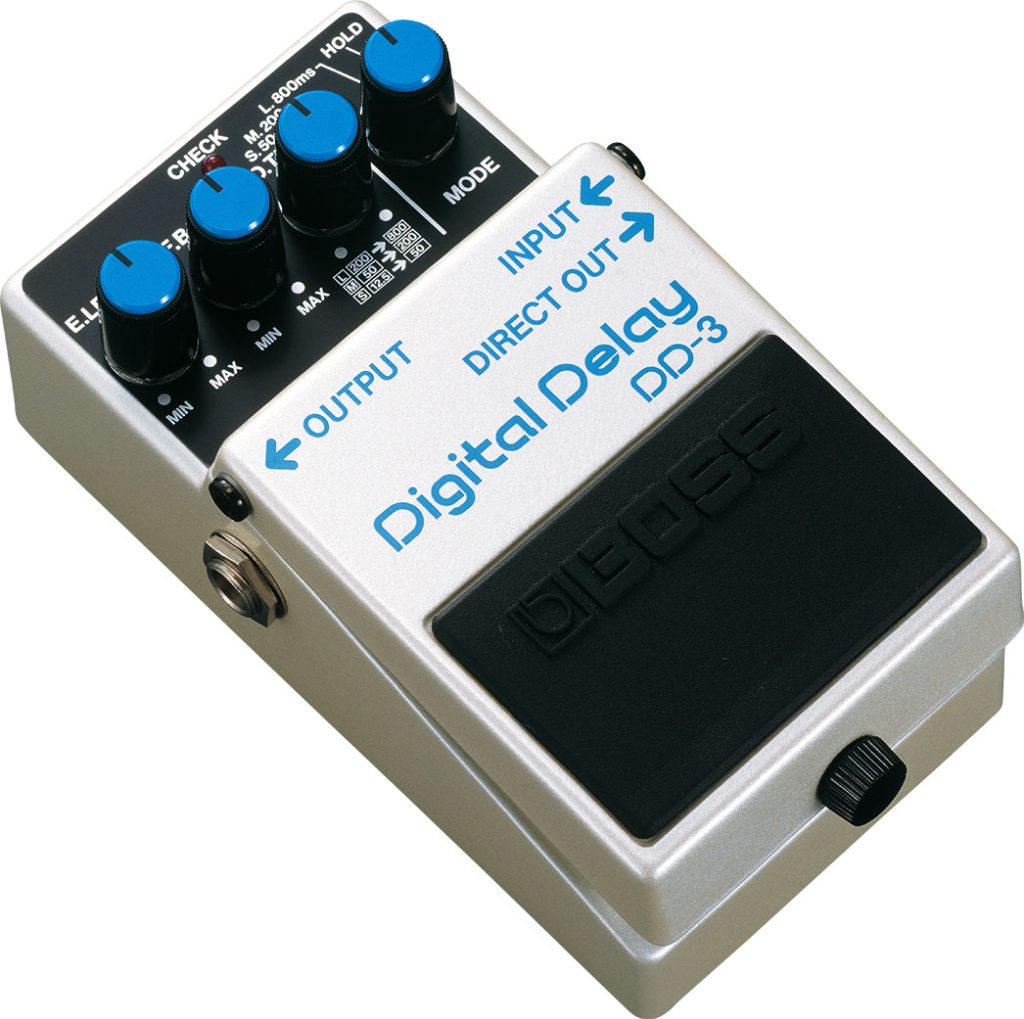
「DD-2、DD-3、DD-3Tにより、オリジナルのコンパクト・エフェクターのデジタル・ディレイは40年以上製造されています」

1986: DSD-3 Digital Sampler/Delay
DD-3と同時にリリースされたDSD-3も、部品コストの急激な低下を利用して、DSD-2の低価格版として市場に登場しました。ケースのモデル名を除けば、DSD-2とDSD-3はほぼ同じペダルです。
1987: RV-2 Digital Reverb
RV-2は業界にとってもう一つの画期的な製品で、世界初のデジタル・リバーブ・ペダルです。ここで取り上げる理由は、複数のサウンド・モードのひとつとしてディレイ機能が含まれているからです。ステレオで使用すると、RV-2のディレイ・モードはパンニング、または”ピンポン”ディレイとして機能し、リピート音が左右の出力を交互に移動します。
「RV-2は業界にとってもう一つの画期的な製品で、世界初のデジタル・リバーブ・ペダルです」
デジタル・リバーブは技術的にはタイム・ディレイの一種です。非常に近接したディレイ・リピートと他の処理を組み合わせて、最終的な音を作り出しています。しかし、多くのミュージシャンはディレイとリバーブを別々のエフェクトとして捉え、やや異なる使い方をすることが多いため、このレビューではそれぞれを独立したエフェクト・カテゴリとして扱っています。
RV-2について言及するなら、BOSSにとって大きな技術的成果であった点も注目に値します。というのも、RV-2には同社が開発した完全新規のカスタムDSPチップが採用されていたからです。この第1世代チップは、Micro RackシリーズのRRV-10デジタル・リバーブ用に設計されたもので、コンパクトなペダルでこれまでにない処理能力を提供しました。そのため、RV-2は多くの電力を必要とし、付属のACアダプターでしか動作しない、BOSSとしては珍しい仕様となっていました。
1987: PS-2 Digital Pitch Shifter/Delay
人気のOC-2オクターブ・ペダルが1982年から販売されていたものの、PS-2はBOSSのペダルの中で初めて連続可変ピッチ・シフティングを搭載したモデルでした。MANUALモードでは、1オクターブ上げたり下げたり、またその中間の任意の音程に設定することが可能でした。専用の出力ジャックが用意されており、外部チューナー(当時のBOSS TU-12など)と接続できるため、プレイヤーはMANUALノブを使って音程の微調整ができます。今日のプッシュボタン基準では少し不便に感じるかもしれませんが、当時としては最先端の技術でした。また、PS-2はそのモードの1つで最大2秒のディレイ・タイムを提供することができ、これもBOSSのディレイ・ペダルとしては初の試みでした。

「PS-3は新たに開発されたDSPと最新技術を取り入れて、前モデルよりも優れたパフォーマンスを実現しました」

1994: RV-3 Digital Reverb/Delay
RV-3はRV-2の後継モデルであり、新しいカスタムDSPやデジタル技術の全体的な向上により、パフォーマンスが大幅に向上しました。さらに、価格が安く、9Vのバッテリーでも動作することができました。RV-3では、リバーブの品質が向上しただけでなく、ディレイ機能も大幅に拡張されました(そのため、製品名に「Delay」が追加されました)。最大2秒のストレート・ディレイに加えて、ペダルの4種類のリバーブ・タイプとディレイ効果を組み合わせたモードも利用可能でした。想像できるように、これらの素晴らしい機能のおかげで、非常に人気のあるペダルとなりました。
1994: PS-3 Digital Pitch Shifter/Delay
RV-3と同様に、PS-3は新たに開発されたDSPと最新技術を取り入れて、前モデルよりも優れたパフォーマンスを実現しました。ディレイ機能はPS-2と同じですが、ピッチシフティング能力は大幅に拡張されました。ピッチは上下2オクターブ以上の範囲でシフトでき、コーラスのような音色を作るためのDETUNEモードも用意されています。さらに、これらの機能はDUALモードで使用することもでき、同時に2つの独立したピッチシフトを作成することが可能です。各ピッチシフトは、ステレオ動作のために別々の出力に送ることもできます。
「DD-5は最大2秒のディレイ・タイムに加え、11種類の異なるディレイ・モードを提供し、当時では最も先進的なペダル・ディレイとなりました」
1995: DD-5 Digital Delay
RV-3、PS-2、PS-3のペダルが、ディレイ機能以外にも2秒までのディレイタイムを提供していることに気付いた人もいるでしょう。これは、前回のペダルであるDD-3が提供する最大800msの倍以上の時間です。BOSSはこの性能のギャップに対処するためにDD-5を開発し、多くのハイエンド機能も追加しました。
DD-5は最大2秒のディレイ・タイムに加え、11種類の異なるディレイ・モードを提供し、当時では最も先進的なペダル・ディレイとなりました。リバース・ディレイがBOSSペダルに初めて登場し、ホールド機能はDD-2/DD-3の”ホールド・スタイル”の一時的機能から、シンプルな2秒のルーパーとして進化しました。また、外部フットスイッチを使用してテンポを同期させたディレイも利用可能でした。ステレオ出力により、モードに応じたパンニング・ディレイや、直接信号とエフェクト信号の分離も可能です。
DD-5は大成功を収め、BOSSは当初、DD-3を置き換えると考えていました。しかし、DD-3のシンプルさと素晴らしいサウンドは多くのプレイヤーにとって絶妙なバランスを保ち続けており、それが現在でもラインナップに残っている理由です。
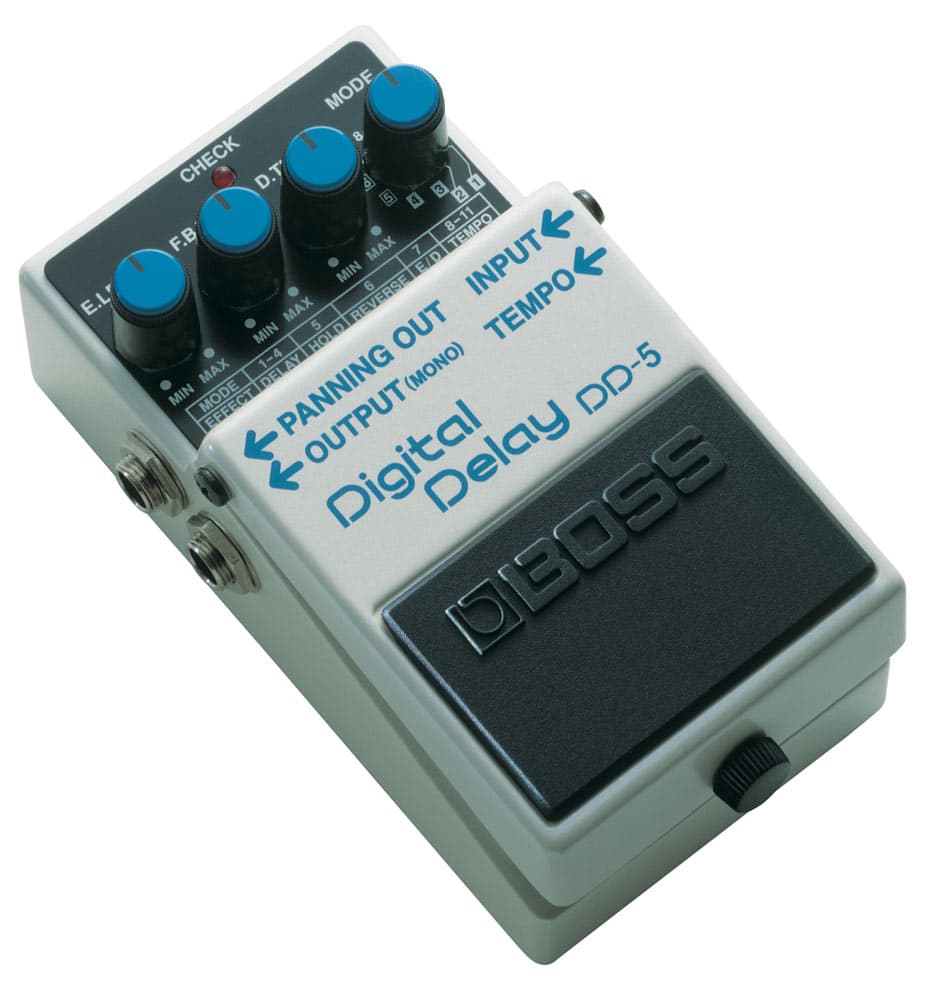
「2001年に発表されたTwin Pedalシリーズは、BOSSマルチエフェクト・ユニットの幅広い機能を備えています」

2002: DD-6 Digital Delay
7年後、DD-6はDD-5の印象的な機能セットをアップデートし、機能を拡張しました。まず、最大ディレイが5.2秒に伸び(LONG DELAY MODE使用時)、タップ・テンポ機能をオンボード・ペダル・スイッチで操作できるようになりました。ホールド機能も強化され、5.2秒の録音時間とサウンド・オン・サウンドのオーバーダビングが可能になりました。そして、このペダルは真のステレオI/Oを備えています。これらの機能調整に加えて、DD-6には、ペダル・スイッチを押し続けることでテープ・スタイルのピッチとオシレーション効果を生み出す、新しいWARP MODEが導入されました。
2003: DD-20 Giga Delay
2001年に発表されたTwin Pedalシリーズは、BOSSマルチエフェクト・ユニットの幅広い機能(拡張機能、プログラマビリティなど)を備えながら、ストンプボックス型の直感的で実践的な操作を取り入れています。クリエイティブなミュージシャンはこのアプローチの虜となり、シリーズは追加モデルによって瞬く間に普及しました。
「DD-20はTwin Pedalのフォーマットにデジタル・ディレイをもたらし、瞬く間にストンプ・フォームで高度なディレイ機能を求めるプレイヤーの定番となりました」
2003年、DD-20はTwin Pedalのフォーマットにデジタル・ディレイをもたらし、瞬く間にストンプ・フォームで高度なディレイ機能を求めるプレイヤーの定番となりました。スタンダードなDD-3調のディレイ、温かなBBDアナログやテープの再現(デュアルヘッドのスペース・エコー・エフェクトを含む)、リバース、SOS(サウンド・オン・サウンド)など、11種類のサウンド・モードが様々なディレイの風味を実現しています。DD-6のWARP MODEも搭載され、独自性のある音と相性のいいSMOOTH MODEとTWIST MODEが新機能として加わりました。
23秒という驚異的なディレイ・タイム、便利なLEDディスプレイ、現在のマニュアル・セッティングに加えて4つのディレイ・セッティングを保存できるメモリーなど、DD-20は発売当時トップ・クラスの性能を備えていましたが、現在でもその素晴らしさは変わりません。オンボードの2つのペダル・スイッチは、タップ・テンポ、メモリー選択、その他のディレイ操作に簡単にアクセスでき、外部フットスイッチを接続してさらに操作することもできます。
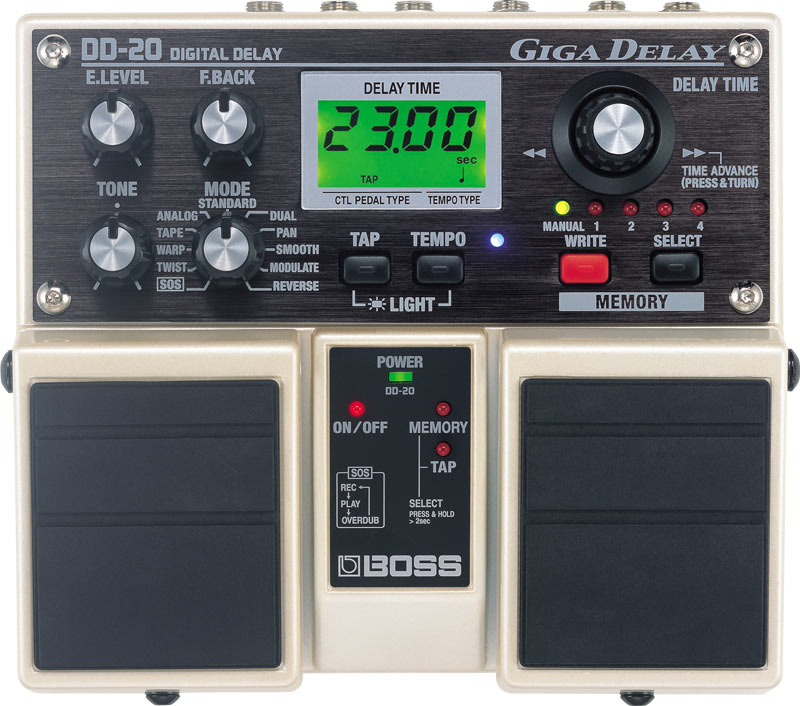
「3つのプレイバック・ヘッド、内蔵スプリング・リバーブ、特徴的な12ポジションのモード・セレクターを備えたRE-201は、使いやすく、創造的かつ有機的なエコー・エフェクトを幅広くかけることができました」
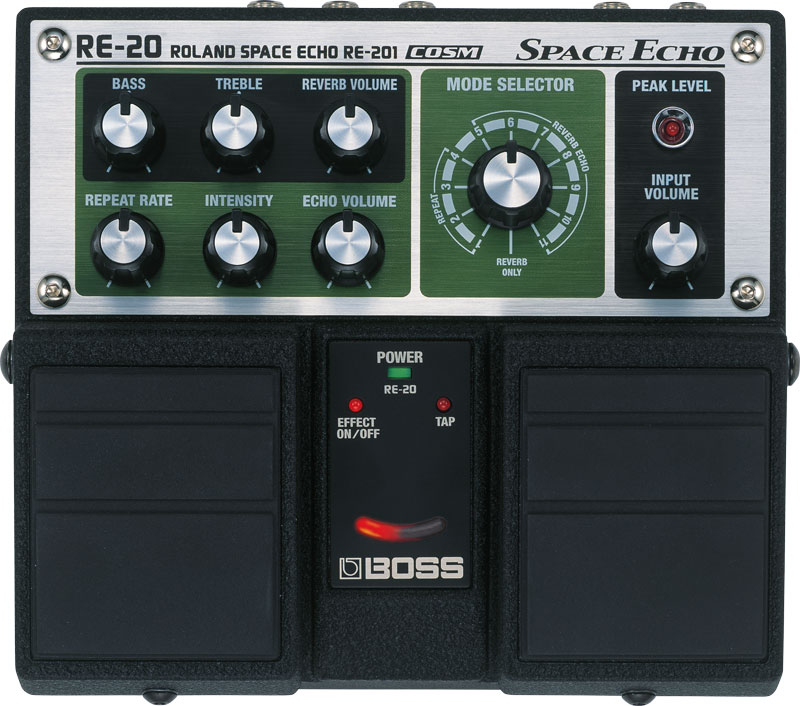
2007: RE-20 Space Echo
Rolandが70年代から80年代にかけて製造したSpace Echoは、テープを基調としディレイ機器の最高峰のひとつとされ、現在でも高く評価されています。長年にわたって多くの異なるモデルが登場しましたが、RE-201 Space Echoは不朽の名作であり、最も人気がありました。
3つのプレイバック・ヘッド、内蔵スプリング・リバーブ、特徴的な12ポジションのモード・セレクターを備えたRE-201は、使いやすく、創造的かつ有機的なエコー・エフェクトを幅広くかけることができました。そのため、レコーディング・セッションから一流のコンサート・パフォーマンスまで、様々なシーンで活躍しました。Space Echoは、初期のエレクトロニック・ミュージック・アーティストによるレゲエ主体のダブ・サウンドにも欠かせない存在です。
ツイン・ペダル・シリーズの1つであるRE-20は、BOSSのCOSMテクノロジーを採用し、クラシックなRE-201 Space Echoを隅から隅まで完全に再現しています。RE-20では、本来の操作がリアルタイムの動作とともに再現されています。例えば、オーディオ信号が存在する状態でREPEAT RATEに手を加えると、RE-201の物理的なモーターがテープ・ループを徐々に遅くしたり速くしたりする際の独特なピッチ・シフト動作を模倣することができます。
「DD-7は、1台の小さなペダルで驚くべき量のディレイの多様性を実現しました」
RE-20は、ステレオ対応やタップテンポ制御などの便利な機能を数多く搭載していました。ツイスト機能では、ペダルを押すだけで複数のディレイ・パラメーターが変化し、ギタリストがダブ・スタイルのエコー効果を簡単に再現できるようになっていました。またRE-20のノブを手動で操作することでも、同様のエフェクトを作ることができます。さらに、デジタル設計のおかげで、定期的なテープ交換や他のメンテナンスの煩わしさも不要となりました。
BOSSは、後のモデルでSpace Echoのサウンドを再度探求し、2022年にはRE-202とRE-2ペダルが特に注目を集めました。
2008: DD-7 Digital Delay
DD-7は、人気を博した先代DD-6を進化させたBOSSコンパクト・シリーズのフラッグシップ・ディレイ・ペダルです。最大ディレイ時間が6.4秒に延長され、外部フットスイッチや外部ペダルを使用してタップテンポ、フィードバック、ディレイ・タイムなどの機能を操作できるようになりました。さらに、HOLD MODEでは最大40秒のサウンドオンサウンド録音が可能で、ループ作業においても高い性能を発揮しました。また、DD-20から取り入れたANALOG MODEとMODU LATE MODEも搭載し、DD-7は1つの小型ペダルで驚くほど多様なディレイ効果を備えました。

「TE-2は、BOSSのマルチ・ディメンショナル・プロセッシング(MDP)技術を採用した初期のエフェクトのひとつです」
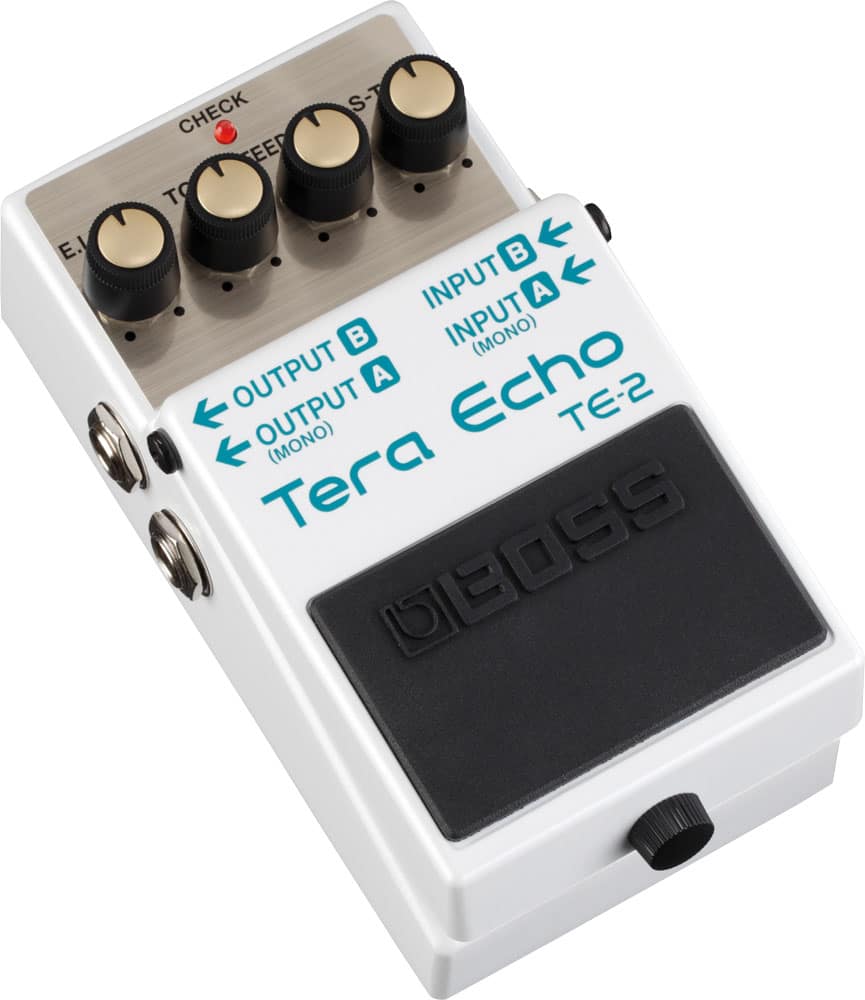
2013: TE-2 Tera Echo
TE-2は、BOSSの長い歴史を持つコンパクト・シリーズで記念すべき100番目のモデルです。これまでの革新の精神を体現し、独特な色合いを持つアンビエンス効果を提供します。
BOSSのマルチ・ディメンショナル・プロセッシング(MDP)技術を採用した初期のエフェクトのひとつであるTE-2は、信号の周波数やダイナミクスを継続的に解析することで、非常に表現力豊かな演奏体験を生み出します。Tera Echoのサウンドは、ディレイ、リバーブ、フィルタリング、ピッチ・モジュレーションの要素を含んでおり、ペダルのノブを調整することで、微妙なリバーブ効果から長く渦巻くアンビエントな音までさまざまなサウンドを生み出すことができます。ペダルスイッチを押し続けると”フリーズ機能”が作動し、エフェクト音を保持して、その上に被せるように演奏するためのアンビエントな土台を作り出します。
「DM-2WのSTANDARD MODEでは、オリジナルのDM-2を完全に再現しており、オリジナルをクラシックとして名高くしたのと同じリッチなアナログ・トーンを作り出します」
2014: Waza Craft DM-2W
1980年代にDM-2とDM-3のアナログ・ディレイが生産終了した後、ギタリストたちは現代のデジタル_ユニットとは一味違う、荒々しくオールドスクールな音色を求めて中古市場に集いました。特に人気が高いのはDM-2で、その温かくざらついたディレイ・トーンはレトロな音楽性を強く漂わせるため、多くの支持を集めています。
30年以上の時を経て、このペダルはWaza Craft DM-2Wとして復活しました。STANDARD MODEでは、オリジナルのDM-2を完全に再現しており、その豊かなアナログ・トーンでクラシックな存在としての評価を受けています。しかし、単なる復刻版にとどまらず、BOSSはディレイ・タイムを800ms以上に拡張し、音のざらつきを少しクリーンにして明瞭さを増したCUSTOM MODEを追加しました。また、DM-3から採用された、ドライとエフェクト・サウンドを別々のアンプに送る機能も備えています。さらに、ディレイ・タイムをエクスプレッション・ペダルで操作できるという、DM-2やDM-3にはなかった現代的な機能も搭載しています。
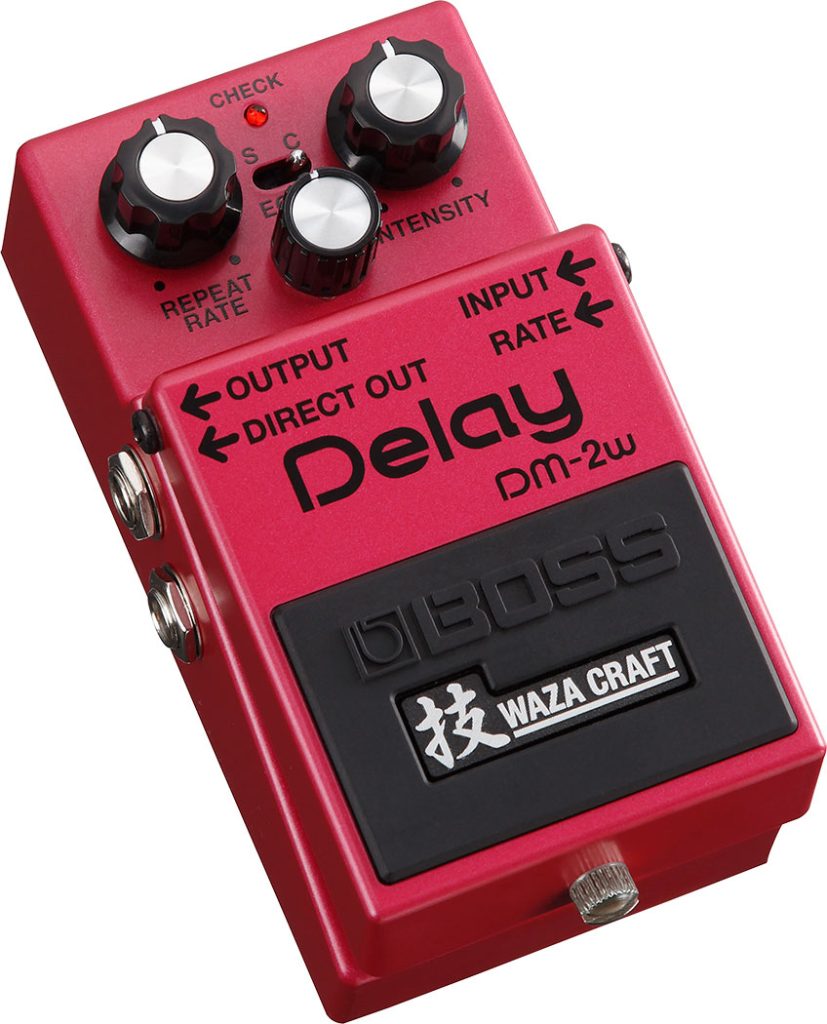
「RV-6は新たな高みへと到達し、より高価なブティック・ペダルやスタジオ・ラック・ユニットに匹敵する、あるいはそれを超える広がりのあるトーンを実現しています」

2015: RV-6 Reverb
BOSSの最新コンパクト・シリーズのリバーブ・ペダルであるRV-6は、12年以上にわたり業界標準として君臨してきたRV-5をアップデートしたモデルです。前作のRV-5の音も優れていましたが、RV-6はそれをさらに上回り、ブティック・ペダルやはるかに高価なスタジオ・ラック・ユニットに匹敵する、あるいはそれ以上の広がりのあるトーンを実現しています。
RV-2やRV-3のペダルではDELAY MODEも搭載されていましたが、RV-5ではリバーブのみに集中していました。ユーザーからの多くの要望を受け、RV-6では一部のディレイ機能が復活しています。+DELAY MODEでは、エコーとリバーブがブレンドされ、壮大で豊かなサウンドを作り出します。TIMEノブやTONEノブを調整すると、リバーブとディレイの特性が多面的に調整され、どの設定でも理想的な音色を実現します。
「DD-500は、市場に登場した中で最も強力で多用途なストンプ・ボックス・ディレイの1つです」
2015: DD-500 Digital Delay
優れた32bit/96 kHzのオーディオ品質、幅広いサウンドモード、使いやすさを備えたDD-500は、市場に登場した中で最も強力で多用途なストンプ・ボックス・ディレイの一つです。まさに、夢にまで見た理想のディレイ・ペダルと言えるのが、BOSSのDD-500です。
これまでの数十年にわたって得たディレイ・エフェクトに関するすべての知識を、BOSSはDD-500に詰め込んでいます。このペダルを使えば、BOSSのディレイ製品のほぼ全てのペダルや、Roland SDE-3000、Space Echoといったクラシックな機材の音を再現できます。さらに、ディレイにフィルタリング、モジュレーション、ピッチシフト、その他の処理を組み合わせた新鮮で現代的なエフェクトも満載です。また、297のオンボードメモリ、深いリアルタイム・コントロール、2つのディレイ・エフェクトを同時に実行するオプションなど、多様な機能が揃っています。DD-500を1つで、どんな音でも作り出すことができます。
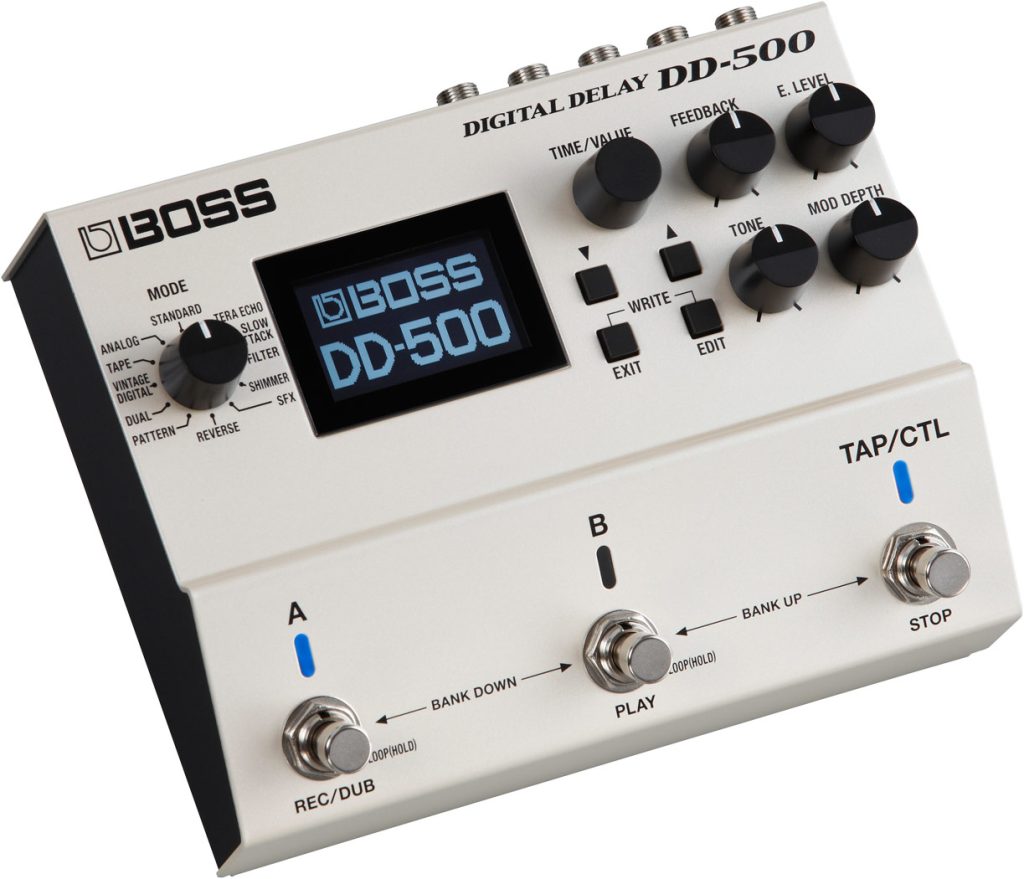
「全ての200シリーズ・ペダルと同様に、DD-200はペダルボードのスペースを節約するスリムな筐体を特徴としています」
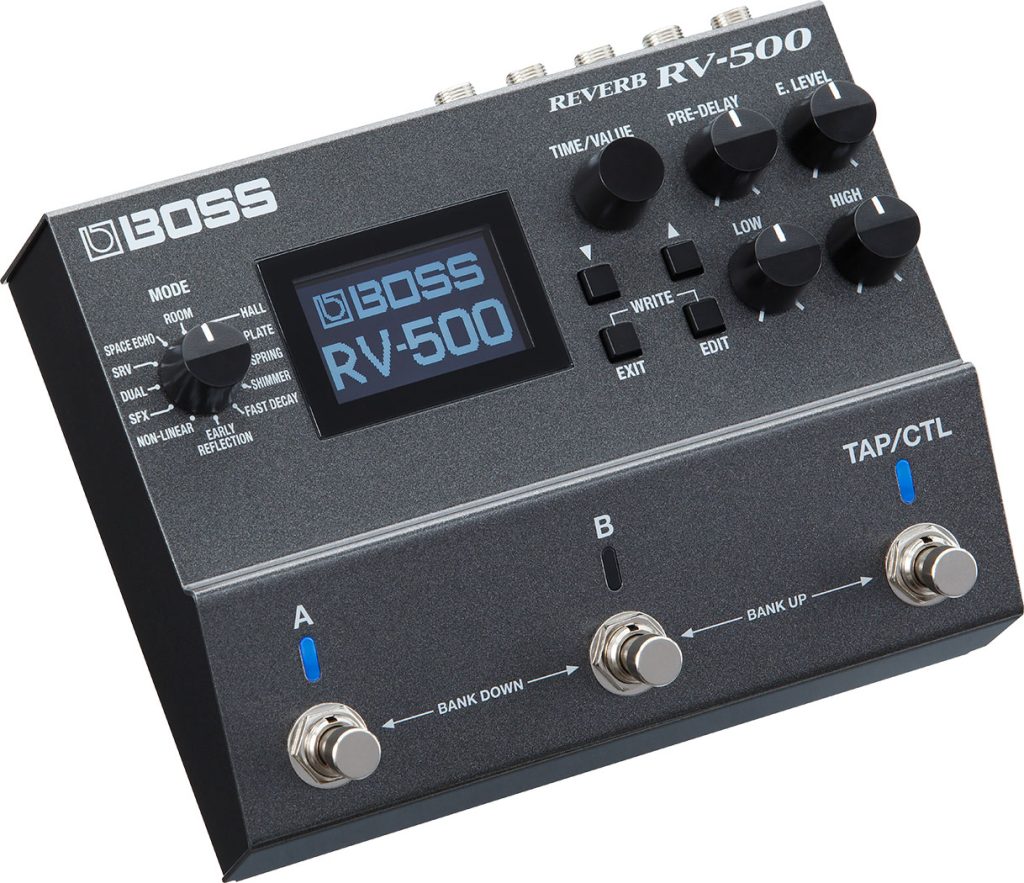
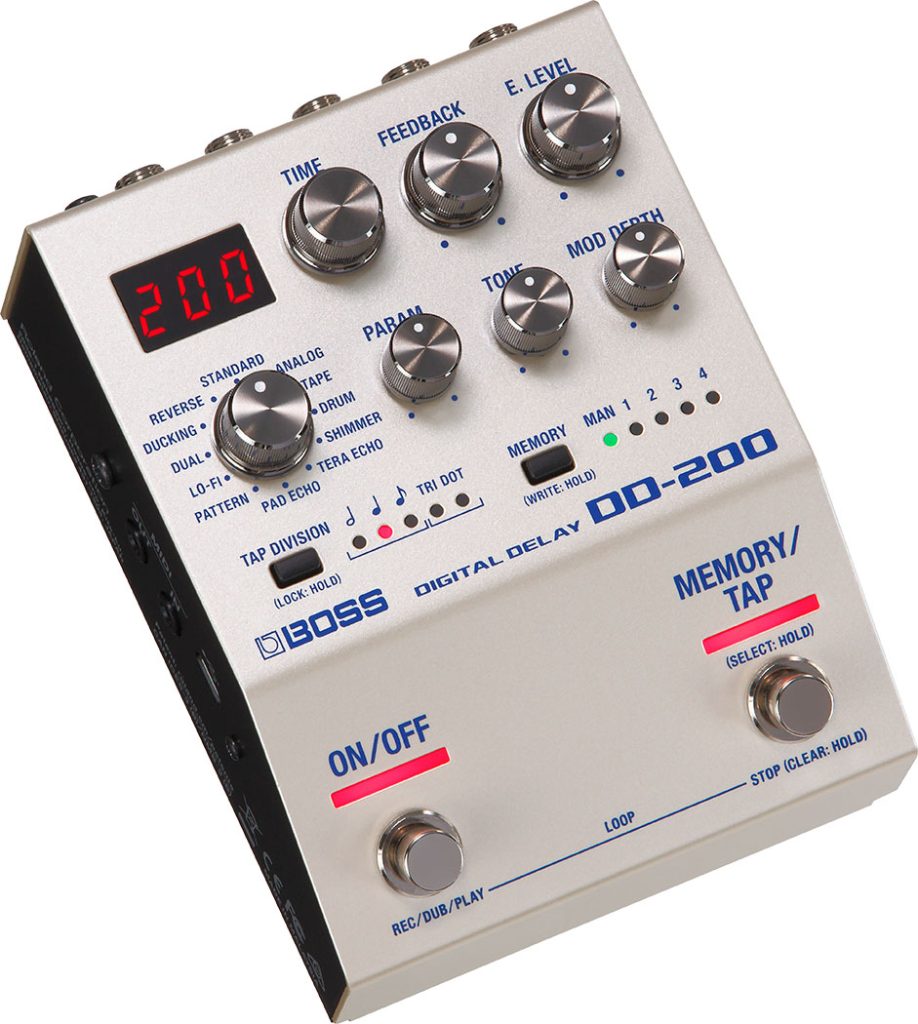
2017: RV-500 Reverb
500シリーズは、2017年に新たなフラッグシップ・リバーブ・ペダルであるRV-500の登場により拡張されました。強力なデジタル・リバーブ・エンジンに加え、すべてのパッチにはフル機能のディレイ・エフェクトが利用可能です。モジュレーション、EQ、リバーブとディレイ・エフェクトを直列または並列で設定できる包括的なパラメータセットを備えています。しかし、RV-500はさらに進化しており、12種類の主要モードの1つとして正確なRE-201 Space Echoを再現しています。
2019: DD-200 Delay
2019年にDD-200ディレイを含む4つのペダルモデルが登場し、BOSS 200シリーズはコンパクト・シリーズのシンプルさと500シリーズのパワーを融合させました。全ての200シリーズ・ペダルと同様に、DD-200は貴重なペダルボードのスペースを節約するために、スリムな筐体を特徴としています。DD-500から移植した様々なディレイ・サウンドに加え、アンビエントなテクスチャーのためのパッド・エコー・エフェクトも提供します。パネル上のノブにより、簡単に各モードのサウンド調整が迅速に行え、127のユーザー・メモリーがパネルまたはMIDI経由で利用可能です。
「DD-3Tは、長年のBOSSのアイコンに実用的かつ現代的な機能を追加したモデルです」
2019: DD-3T Delay
DD-3Tは、長年のBOSSのアイコンに実用的かつ現代的な機能を追加したモデルです。サウンド回路とコントロールはDD-3と同一で、多くの人に親しまれたクラシックな雰囲気を作り出します。注目すべき追加機能はタップテンポです。現代のリズミック・ディレイ・エフェクトに欠かせない機能で、オンボードのペダルスイッチを押し続けるか、外部フットスイッチを接続することで利用できます。タップ情報が受信されると、最大800msのディレイ・タイムが利用可能になり、MODEノブでタップの細分化を設定します。また、ダイレクト出力ジャックは、接続しやすいようにペダルの左側に移動しました。
2019: DD-8 Delay
コンパクトシリーズの中でも最新かつ最強のディレイであるDD-8は、DD-7の前モデルに比べて機能が大幅に拡張されています。新しいウォームやグリッチ・タイプ、さらにディレイとリバーブを組み合わせた+RVタイプなど、11種類のディレイ・モードを提供します。タップ・テンポ機能を使用することで、最大10秒のディレイ・タイムが得られます。また、最大40秒のモノ録音時間(ステレオでは20秒)のルーパー機能も搭載しています。
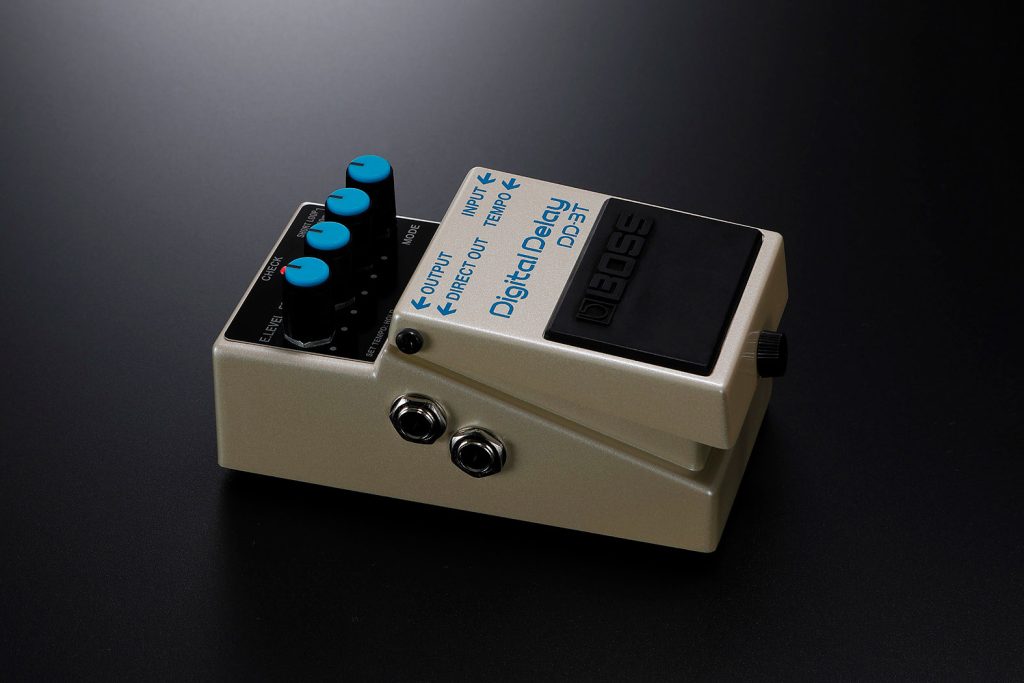

「RE-202は、RE-201のヴィンテージ・マジックを忠実に再現しています。磁気テープやモーター特性から、鮮やかなスプリング・リバーブやカラフルなプリアンプ回路まで、あらゆる点でその魅力が詰め込まれています」

2022: RE-202 Space Echo
2007年の発売以来、RE-20はクラシックなSpace Echoの音色と雰囲気を表現豊かに再現することで親しまれてきました。RE-202は、最新のBOSS技術の進歩を活用し、RE-201 Space Echoの本物のニュアンスをこれまでにないほど生き生きと再現しています。
RE-202は、RE-201のヴィンテージならではの魔法を完璧に捉え、磁気テープやモーター特性から、鮮やかなスプリング・リバーブ、カラフルなプリアンプ回路まで、詳細に再現します。サチュレーションやテープのコンディション、その他の可変コントロールを使用して音の個性を変更でき、WOW&FLUTTERコントロールを使ってSpace Echoサウンドに欠かせない自然なモジュレーション特性の全てを表現できます。
RE-202は、現代のミュージシャンやプロデューサーにとって素晴らしいツールの強化を施しました。2倍のディレイ・タイムに加え、より多くの音の組み合わせを試すことができる4つの仮想テープヘッドが備わっています。真のステレオI/O、選択可能なギター/ライン・レベル操作、クラシックなスプリング・リバーブ・サウンドのステレオバージョンに加え、Hall、Plate、Room、Ambienceのバリエーションも含まれています。ドライ・サウンドでは、温かみのあるRE-201プリアンプ・トーンまたはゼロ・プロセッシングのクリーン信号のいずれかを選択できます。タップテンポ、MIDI I/Oなどの多くのコントロールオプションも用意されています。
「SDE-3000は、完全に独立した2つのステレオ・ディレイ、柔軟な内部ルーティング、全種類のモノラルおよびステレオ・リグとの統合のための拡張I/Oを備えています」
2022: RE-2 Space Echo
RE-202と同時に発売されたRE-2は、上位モデルのサウンド・キャラクターと必要不可欠な機能を、便利なコンパクト・ペダルに搭載しています。11ポジションのモード・セレクターに加え、リピート・レート、インテンシティ、エコー/リバーブのブレンド・ノブなど、7つのコントロールが効率的なパネルに凝縮されています。ワウ&フラッター・ノブも搭載され、ステレオI/O、エクスプレッション・ペダルや外部フットスイッチによる追加コントロールにも対応しています。
2023: SDE-3000D Dual Digital Delay
SDE-3000D Roland SDE-3000、2台分の機能をフロア型ペダルで実現しました。先に述べたように、DD-2とDD-3のデザインは、あの伝説的なラック・ユニットのコア・チップをベースにしています。SDE-3000Dは、オリジナルのサウンド、インターフェイス、グラフィック・スピリットを完全に再現しながら、多くの現代的な機能を搭載しています。
SDE-3000は、完全に独立した2つのステレオ・ディレイ、フレキシブルな内部ルーティング、あらゆるタイプのモノ/ステレオ・リグと統合できる拡張I/Oを備えています。モジュレーションとトーンシェイピング機能が強化され、カスタムセットアップを保存するための100個のメモリーが用意されています。ディープなMIDIサポートを含め、オンボードと外部コントロール・オプションも充実しています。
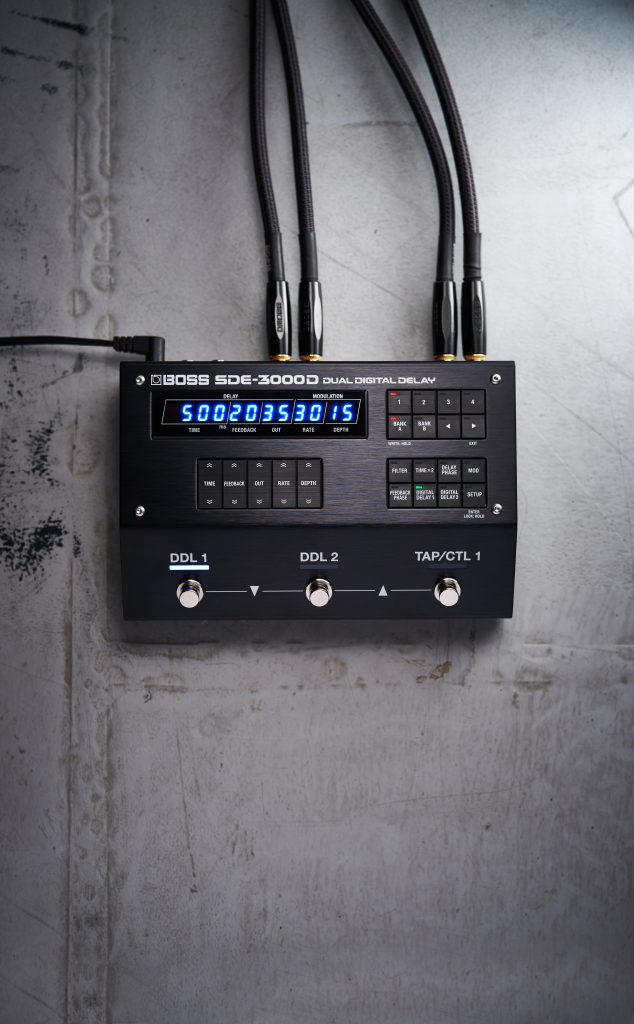
「BOSSとEVHが共同開発したSDE-3000EVHは、エディの巨大な3キャビネット・ライブ・ステージ・ギター・サウンドの心臓部であるステレオ・ディレイを忠実に再現しています」
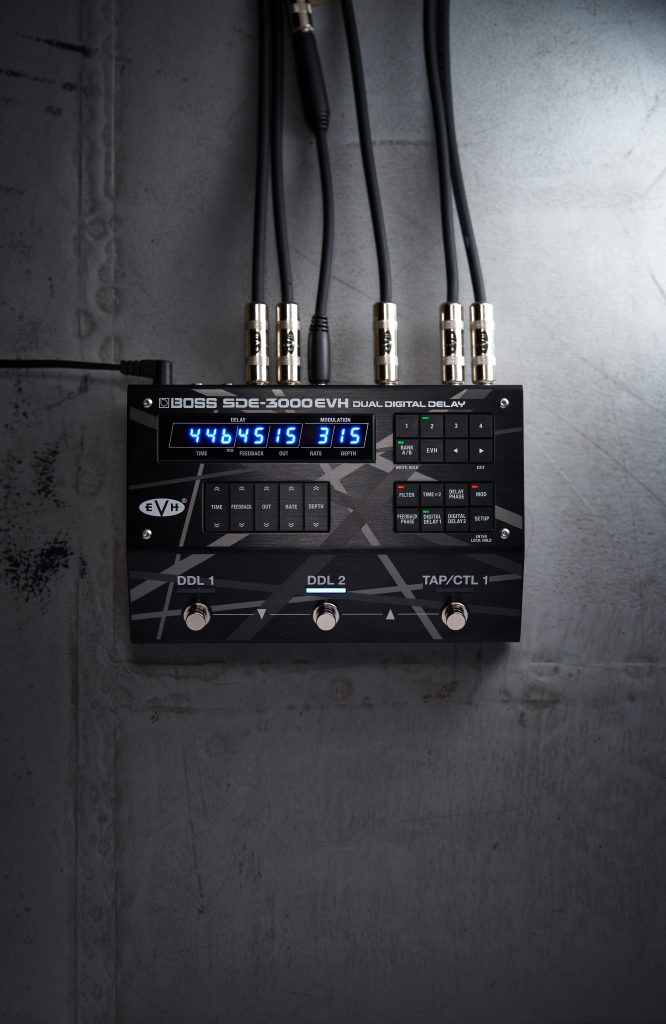
2023: SDE-3000EVH Dual Digital Delay
SDE-3000は、1980年代から1990年代にかけて、世界最高峰のギタリスト、セッション・ミュージシャン、エンジニアにとって最高のディレイ・マシンでした。エディ・ヴァン・ヘイレンは、このSDE-3000を非常に気に入っており、彼のツアー・リグから離れることはなく、彼の象徴的なウェット/ドライ/ウェットのステージ・セットアップの中で、オリジナルのラック・ユニットを2台使用していました。
BOSSとEVHが共同開発したSDE-3000EVHは、Eddieの巨大な3キャビネット・ライブ・ステージ・ギター・サウンドの中核をなすステレオ・ディレイを忠実に再現しています。このSDE-3000Dの特別バージョンには、Eddieのユニットのセッティングを含む8つのEVHプリセットや、ウェット/ドライ、ウェット/ドライ/ウェットのセットアップを作成する際の手間を省く接続オプションなど、マスターのサウンドを再現するための多くの拡張機能が搭載されています。
「1978年に発売されたBOSS初のディレイ・ペダル、DM-1のスピリットにインスパイアされたDM-101は、アナログ・ディレイをかつてないものへと進化させました」
2023: DM-101 Delay Machine
1978年に発売されたBOSS初のディレイ・ペダル、DM-1のスピリットにインスパイアされたDM-101は、アナログ・ディレイをかつてない高みへと導きます。このBOSSの驚異的なエンジニアリングは、クラシックなサウンドと現代のテクノロジーを融合させ、8基のBBDをスマートなCPUコントロールの下で使用することで、100%アナログのヴィヴィッドなトーンを生み出します。12種類のディレイ・モード(うち6種類はステレオ)と、127種類のユーザー・メモリー、タップ・テンポ、キャリーオーバー、MIDIなどの最新機能を搭載しています。アナログ・ディレイのファンなら、DM-101は他のアナログ・ディレイ・ペダルでは味わえない体験を提供します。
2023: RV-200 Reverb
RV-200により、 BOSSは200シリーズのラインナップに強力なリバーブ・エフェクトを追加しました。12種類の多彩なリバーブ・タイプは、繊細な空間色からアンビエント探索のための複雑で夢のようなテクスチャーまで、すべてを提供します。1992年のRV-2から始まった伝統を受け継ぐRV-200には、専用のディレイ・モードが搭載されています。リバーブとディレイを組み合わせた+Delayタイプは、ペダルのノブで両方のエフェクトの長さを調整し、ディレイ・レベルを微調整できます。
物語は続く
BOSSは常に革新を続け、アマチュアからハイエンドのプロまで、あらゆるミュージシャンのニーズをサポートする最高品質のエフェクトを生み出す努力をしています。BOSSのディレイ・ペダルは今後も登場することでしょう。BOSSのチームが次にどんな音楽の魔法をかけてくれるのか、今から楽しみで仕方ありません。
